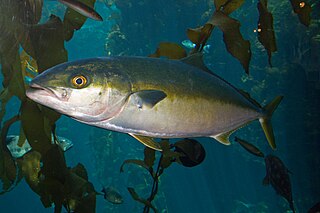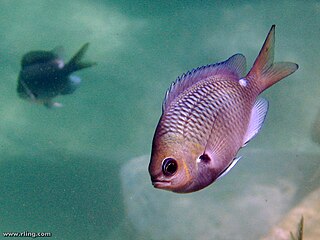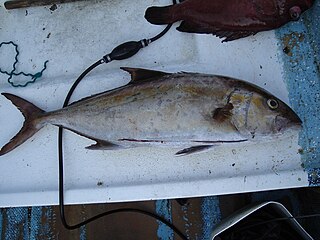
Amberjacks are Atlantic and Pacific fish in the genus Seriola of the family Carangidae. They are widely consumed across the world in various cultures, most notably for Pacific amberjacks in Japanese cuisine; they are most often found in the warmer parts of the oceans. There are many variations of amberjack, including greater amberjack (Atlantic), lesser amberjack (Atlantic), Almaco jack (Pacific), yellowtail (Pacific), and the banded rudderfish (Atlantic). Though most of the Seriola species are considered "amberjacks", the species Seriola hippos is not.

The yellowtail amberjack, yellowtail kingfish, hiramasa or great amberjack is a large fish found in the Southern Ocean. Although previously thought to be found in all oceans and seas, recent genetic analysis restricts S. lalandi proper to the Southern Hemisphere waters. However, they are found in Northern Hemisphere waters during certain times of the year. The fish was given its name by Monsieur de Lalande, a naturalist who first informed zoologist Achille Valenciennes of the existence of this species. His reason for the use of the word Seriola to name the fish is uncertain, but the second word lalandi was derived from his surname.

The Japanese amberjack or yellowtail, Seriola quinqueradiata, is a species of jack fish in the family Carangidae, native to the northwest Pacific Ocean. It is known as shiyu (鰤魚) in China, bang'eo (방어) in Korea, and buri or hamachi in Japan.

The smooth leatherjacket or velvet leatherjacket is a filefish of the family Monacanthidae, found off eastern Australia and all around New Zealand to depths of about 100 m (330 ft), on rocky weedy reef areas. Its length is between 25 and 31 cm. In New Zealand it is simply known as leatherjacket as it is the only fish of this family commonly found there, by the Māori language name kōkiri, or by its commercial name cream fish.

The one-spot puller or brown puller, Chromis hypsilepis, is a damselfish of the genus Chromis, found off south-east Australia and between North Cape and East Cape of the North Island of New Zealand to depths of about 60 metres, off rocky coasts. It grows to a length between 15 and 20 centimetres.

The Australian ghostshark is a cartilaginous fish (Chondrichthyes) belonging to the subclass Holocephali (chimaera). Sharks, rays and skates are the other members of the cartilaginous fish group and are grouped under the subclass Elasmobranchii. Alternative names include elephant shark, makorepe, whitefish, plough-nose chimaera, or elephant fish. It is found off southern Australia, including Tasmania, and south of East Cape and Kaipara Harbour in New Zealand, at depths of 0–200 m (0–656 ft). Despite several of its names, it is not a shark, but a member of a closely related group.

The banded bellowsfish, banded yellowfish, banded snipefish, or bluebanded bellowsfish, is a species of fish of the family Macroramphosidae, found in southern oceans at depths of 35 to 1,000 m. Its length is up to 30 cm (12 in).
The New Zealand dory is a dory, in the family Cyttidae, found around southern Australia, and New Zealand, over the continental shelf at depths of between 20 and 400 m. Its length is between 20 and 30 cm.

The crested bellowsfish or crested bellowfish, Notopogon lilliei, is a species of fish from the family Macroramphosidae. It is a demersal species which occurs over the continental shelf at depths of 80 to 600 m. They grow to lengths of up to 27 cm (11 in).

The greenback horse mackerel or greenback scad is a species of jack in the family Carangidae, found around western and southern Australia, and around New Zealand, from the surface to depths of 460 m. Its length is up to 64 cm.

The toadstool groper, also known as the Pacific rockcod, Pacific perch, Strawberry cod and whitespotted sea bass is a ray-finned fish of the family Anthiadidae which is found in the southern Pacific Ocean. Its length is between 20 and 40 cm.

The Lord Howe Island butterflyfish is a butterflyfish of the family Chaetodontidae, found along the east coast of Australia, around Lord Howe Island, and down the east coast of Northland in New Zealand, at depths of between 10 and 150 m. They are up to 20 cm long with black and yellow/white vertical stripes.

The southern conger is a conger of the family Congridae, found in the eastern Indian Ocean and south-western Pacific Ocean, including southern Australia and New Zealand, at depths down to 100 m in broken rocky reef areas. Length is up to 2 m and weight may be up to 5 kg.

The saddletail grouper, also known as black cod or black rock-cod in Australia, and as saddle-tailed grouper or spotted black grouper in New Zealand, is a large marine fish of the family Serranidae. It is found off the coastline of southeastern Australia and northern New Zealand, generally inhabiting near-shore rock and coral reefs at depths down to 50 metres. Its main range comprises the southeast coastline of Australia, in the state of New South Wales; New Zealand populations are suspected to be nonbreeding, so are a result of drifting larvae. However, spawning aggregations have been recorded off northern New Zealand.

The greater amberjack, also known as the allied kingfish, great amberfish, greater yellowtail, jenny lind, Sea donkey, purplish amberjack, reef donkey, rock salmon, sailors choice, yellowtail, and yellow trevally, is a species of predatory ray-finned fish in the family Carangidae, the jacks and pompanos. It is found in temperate, subtropical, and tropical seas around the world. It is a popular quarry species for recreational fisheries and is important in commercial fisheries. It is the largest species in the family Carangidae.

Seriola is a genus of ray-finned fish, with many species commonly known as amberjacks. Nine extant species are currently recognized, although these were formerly split into many more. Also, several species are currently placed in several other genera of the Carangidae that were originally described under Seriola. They are a large, carnivorous finfish popularly known for the firm texture and rich flavour of their flesh, which make them an ideal fish for aquaculture. Because specimens caught can weigh up to 100 kg (220 lb), and are powerful swimmers and hunters, they are also highly prized by sport fisherman.

Seriola dorsalis, the California yellowtail is a species of ray-finned fish of the family Carangidae. This species is also known by several alternate names, such as yellowtail jack amberjack, forktail, mossback, white salmon and yellowtail tunis or tuna or by its Spanish name jurel. Although previously thought to belong to S. lalandi, recent genetic analysis distinguished California yellowtail as a distinct species from the yellowtail amberjack. The California yellowtail is differentiated from yellowtail amberjack as they differ in range. The yellowtail amberjack is found farther south in the Pacific Ocean.

The lesser amberjack, also known as the false amberjack or little amberjack, is a species of ray-finned fish from the family Carangidae, the jacks and pompanos.

The fortune jack, also known as the darkfin amberjack, is a species of ray-finned fish from the family Carangidae. It is found in the eastern Pacific from Mexico to Ecuador and on the Galapagos Islands. It is a benthopelagic and demersal fish of coastal areas, including areas of rocky reefs to 30 metres (98 ft). This species was formally described by the Austrian ichthyologist Franz Steindachner (1834-1919) in 1881 with the type locality given as Callao in Peru.

The banded rudderfish, also known as the slender amberjack, banded mackerel or shark pilot, is a species of ray-finned fish from the family Carangidae, the jacks and pompanos from the western Atlantic Ocean.




















